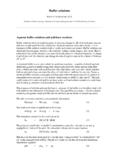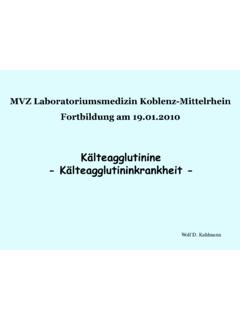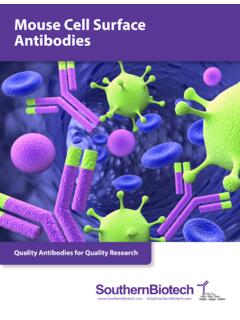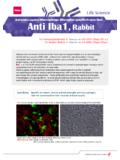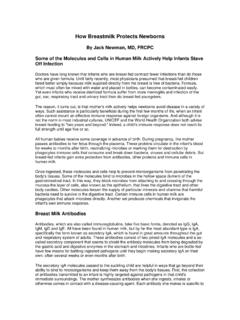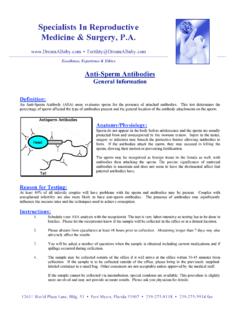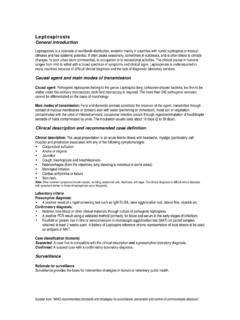Transcription of Immunization, immune sera and the production of …
1 immunization , immune sera and the production of antibodies WOLF D. KUHLMANN, Division of Radiooncology, Deutsches Krebsforschungszentrum, 69120 Heidelberg, Germany The overall characteristic of antibody molecules is the uniqueness with which they bind selectively antigens. Thus, the antigen-binding specificity make antibodies important tools in research, in analytics and diagnostics as well as in therapeutic strategies. antibodies can be produced in vivo or in vitro (Table 1); they can be of polyclonal or monoclonal origin. Table 1: production and features of polyclonal and monoclonal antibodies Procedure Type of antibody Advantage Disadvantage Animal immunization Polyclonal antibodies (hyperimmune sera) Fast and not expensive Unwanted and cross- reacting antibodies Animal immunization followed by fusion of antibody producing cells with myeloma cells ( mouse hybridomas) Monoclonal antibodies (hybridoma) Mass production of homogenous antibody populations Restricted conformational epitope specificity Human hybridomas Monoclonal antibodies (hybridoma)
2 Clinical applications No routine production For research application No significant advantage immunization in vitro followed by fusion of antibody producing cells with myeloma cells ( mouse hybridomas) Monoclonal antibodies (hybridoma) Small amount of antigen required Mainly research area Fusion techniques, electrofusion and antigen-directed fusion (hybridomas) Monoclonal antibodies (hybridoma) Enhanced efficiency in production of hybrido- mas compared to classical fusion tech- nique Mainly research area Cloning of antibody genes in bacteria Recombinant antibodies (gene technology) Selection of antibody specificities which may not emerge in vivo No affinity maturation as in vivo Retroviral vectors, transformation of antibody-secreting cells Recombinant monoclonal or polyclonal anti- bodies (gene techno- logy)
3 Immortalization of antibody secreting plasma cells Mainly research area Proteins and peptides derived from primary sequence (phage display libraries) Recombinant antibodies (gene technology) High selectivity Mainly research area Cloning of antibody Recombinant antibodies High selectivity Mainly research area genes in plants (cDNA from immu- nized animals; phage display librabries) (gene technology) Antibody construction by fusion of Fab with Fc of other species (CDR-grafting) Humanized monoclonal antibody Reduced immunogenicity of mAbs from xeno- geneic sources for clinical application Mainly research area New developed culture media (hybridomas) Monoclonal antibodies (new culture condi- tions)
4 Easy purification of antibodies due to low levels of foreign pro- teins in culture media Mainly research area Polyclonal antibodies immunization of laboratory animals with an antigen results in the generation of a pool of antibodies , with each antibody species produced by a specific B cell clone and recognizing a specific epitope of the antigen. These antibodies are collectively called polyclonal antibodies and are used as affinity reagents for in vitro diagnostics. Since these antibodies can be directed against different epitopes on the same target, they can result in cooperative binding.
5 The use of a population of different antibody types increases the chance that at least one type of antibody will bind the target. However, the major disadvantage is that polyclonal antibody production is not exactly reproducible, even if the same type of animal is immunized with the identical antigen. This phenomenon is due to the way in which B cells mature during the immune response. For the production of antibodies , one can start with purified proteins, cDNA or PCR fragment for the antigen, peptides or haptens. Even today, polyclonal antibodies are usually obtained by immunization of animals.
6 Hyperimmunization is achieved according to injection schedules in which animals are repeatedly boosted with the same antigen. Hyperimmune sera contain many antibody populations specific for a broad range of epitopes of a given antigen (including denaturation resistent epitopes). Polyclonal antibodies not only differ with respect to the epitopes they recognize on the immunizing antigen, but may also differ in their affinity for the same determinant. Hence, specificity and affinity must be considered together when characterizing polyclonal antibodies in hyperimmune sera. antibodies from hyperimmune sera usually work well on fixed tissue samples, and, thus are a good source for immuno-stainings of aldehyde fixed tissues and paraffin sections.
7 However, apart from the above objections, polyclonal immune sera may contain irrelevant antibodies of unknown specificity which can create troublesome problems for immunohistology. Even sera from nonimmunized animals can give background when used at high concentration. Part of this background will come from nonspecific antibody binding to the tissue preparation, another part will be due to specific interaction of irrelevant antibodies . Thus, immunoaffinity purification of the specific antibodies should be performed for clear cell staining patterns. Immunogenicity is the ability of a molecule to induce an immune response, and this is determined by the structure of the injected molecule and by the fact whether or not the host can recognize this substance.
8 With respect to protein antigens, one has to consider that a single gene may generate different protein isoforms, for example by alternative splicing of the primary gene transcript giving multiple different mature transcripts coding for (immunologically) different proteins. Furthermore, complexity to proteins derived from a single gene is added by posttranslational steps such as glycosilation and proteolytic processing. Proteins including peptides, carbohydrates, carbohydrate-protein complexes (glycoconjugates), nucleic acids, lipids and many other natural or synthetic compounds are to be considered as immunogens.
9 For a successful immunization , the compound must contain an epitope that can bind to the surface receptor of a B cell (cell surface antibody) and, in general, it must promote cell-to-cell communication between B cells and helper cells. Source and purity of antigens are critical points in immunization . Before starting an immunization protocol, the major decision to be made is how pure should the antigen need to be. When highly specific antibodies are an essential prerequisite, then the antigen must be of purified to homogeneity; alternatively, the antigen preparation should be used to prepare monoclonal antibodies .
10 Standard techniques for purification include affinity chromatography, differential extraction, subcellular fractionation, or if the protein of interest can be seen as a unique band on a SDS-polyacrylamide gel, the gel can be used as a suitable purification step. Small changes in the antigen structure can largely affect the strength of antigen-antibody interaction. Also, changing the amino acid residues that form the binding site of an antibody molecule can alter the strength of an antigen-antibody interaction (low and high affinity antibodies ) as to be observed in the hypervariable regions of the antibody (the actual binding sites for the antigen which are referred to as the complementarity determining regions or CDRs).
